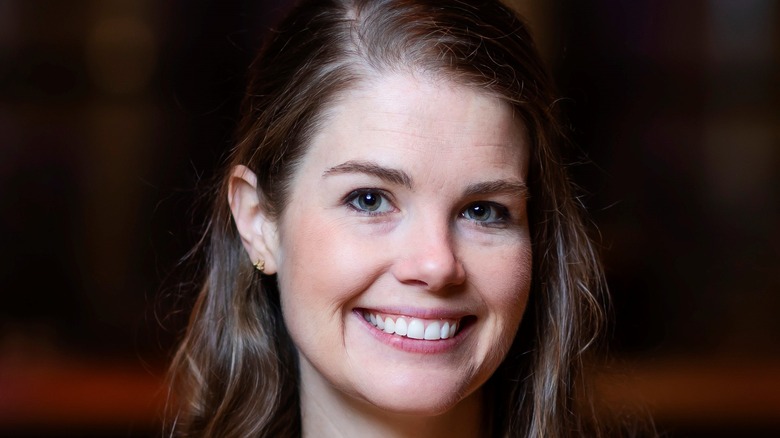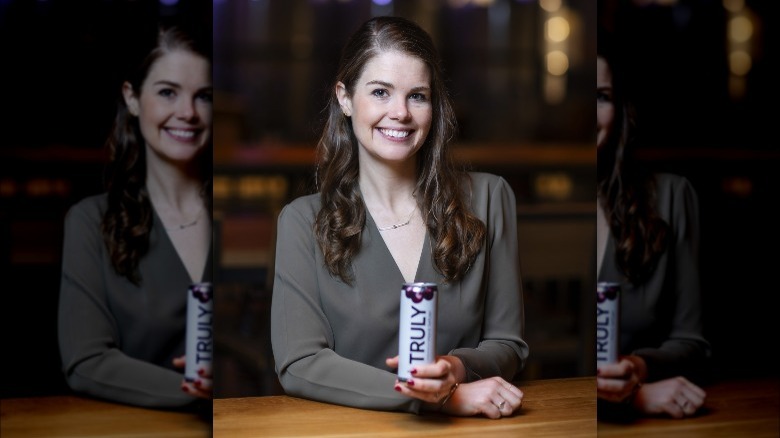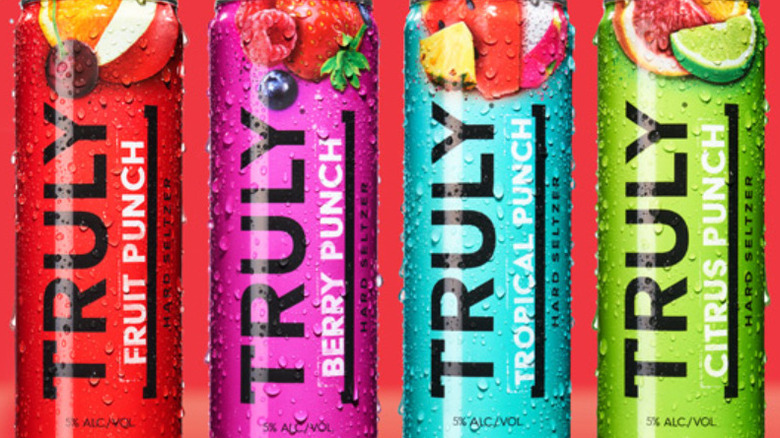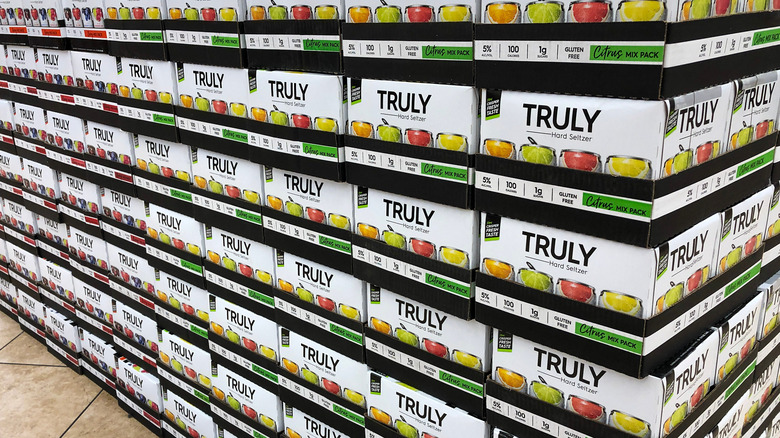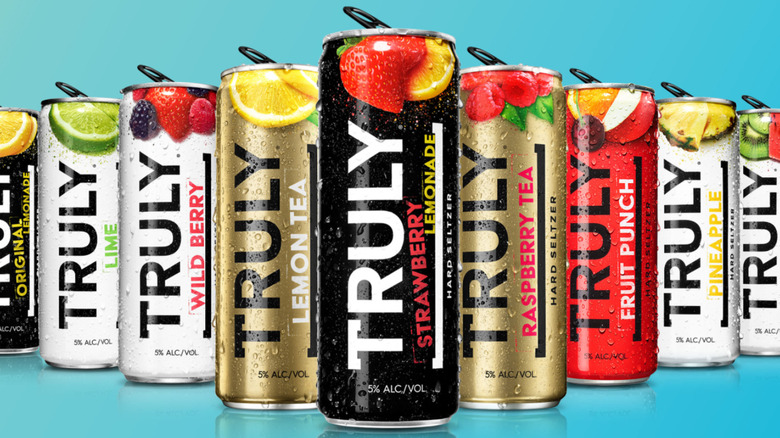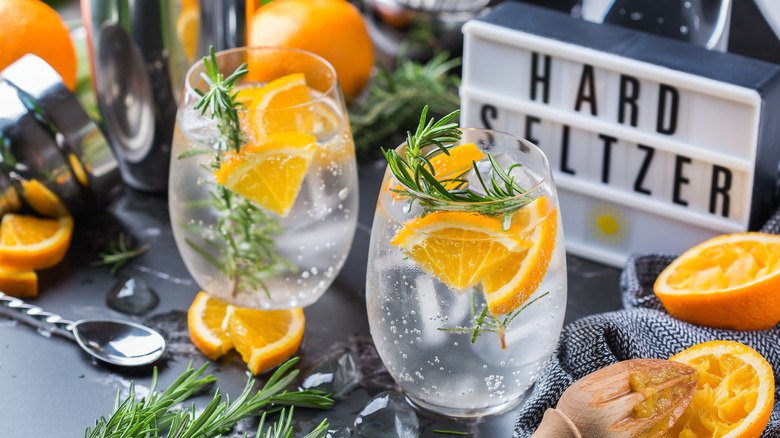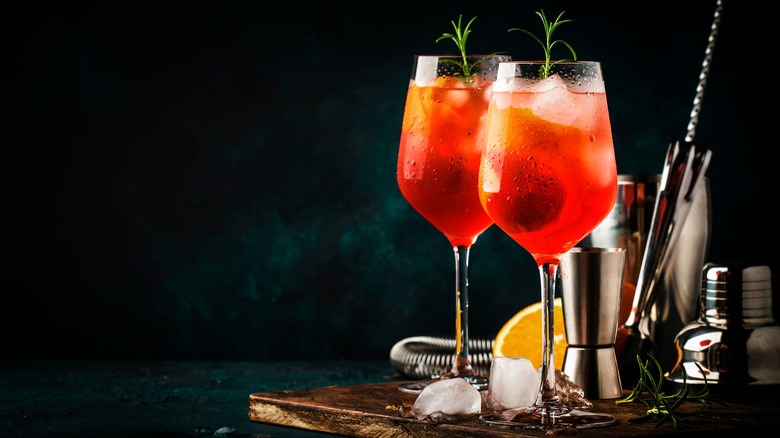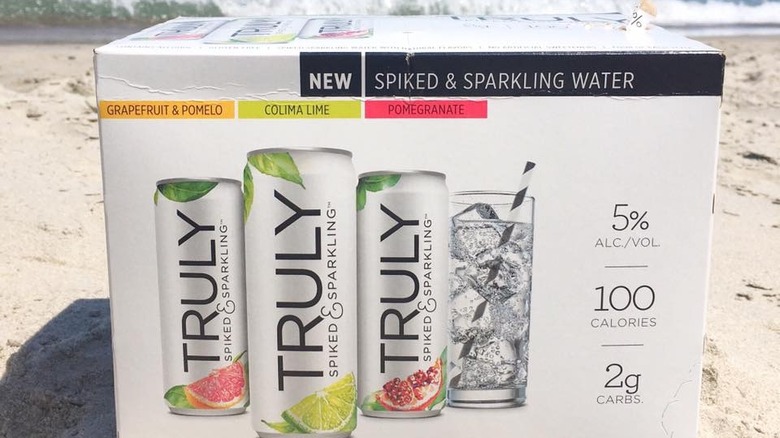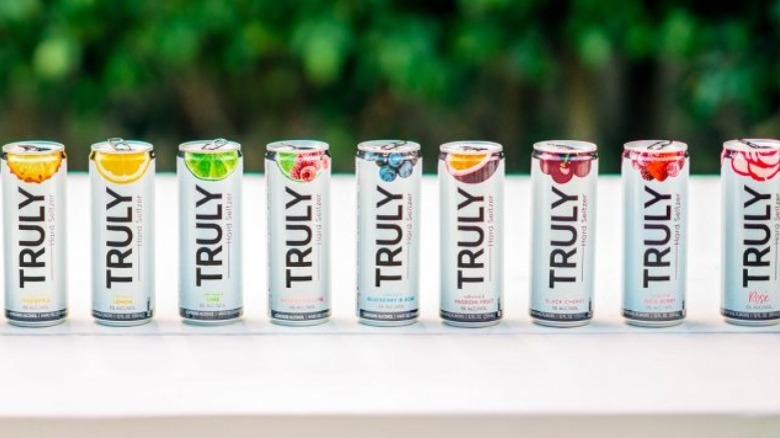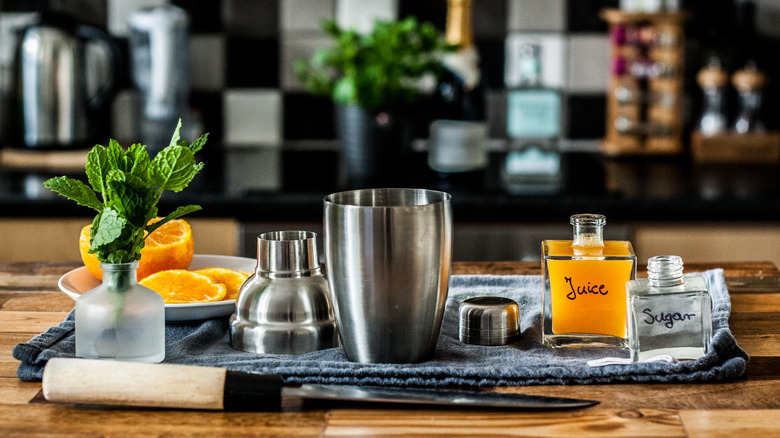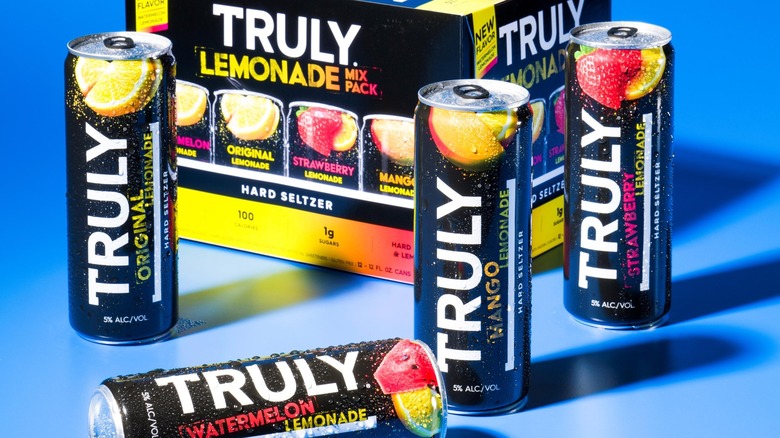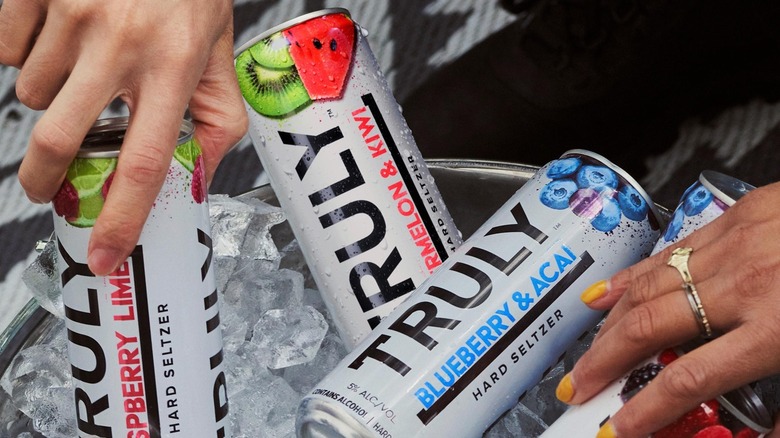Truly's Casey O'Neill Tells Us Everything We Need To Know About Hard Seltzer - Exclusive Interview
Technically speaking, hard seltzer didn't exist before 2015. In less than six years, it's grown to command a 2.6% market share of all consumable alcohol sold in the U.S., a number predicted to triple by 2023, according to International Wine and Spirit Research. Even if you've not yet answered hard seltzer's siren song, you've no doubt witnessed the phenomenon in action: tall, slender beverage cans splashed with vibrant colors and promising fizzy refreshment at 5% ABV — hoisted at outdoor venues by young, athletic-looking, tastefully-tattooed forearms. Hard seltzer is, in fact, a movement, and a lion's share of the credit for its meteoric rise belongs to an impressive young woman by the name of Casey O'Neill.
O'Neill is the Director of Product Development at The Boston Beer Company (home of Sam Adams, Dogfish Head, and Angry Orchard), where she's been coming up with innovative beverage ideas since she was still an undergraduate at Northeastern University. Now a candidate for her second master's, this one in food science and human nutrition, her first being in innovation, O'Neill came up with the idea for Truly Hard Seltzer after she and some CrossFit friends found themselves searching fruitlessly for a lightly alcoholic beverage they could kick back with after their workout — that wouldn't undo their hard work. Mashed had the pleasure of sitting down with O'Neill for an exclusive interview during which she broke down everything there is to know about hard seltzer, its origin story, and its extraordinarily promising future.
Casey O'Neill's healthy lifestyle contributed to a lightbulb moment that led to the creation of Truly Hard Seltzer
I've read about your commitment to a healthy lifestyle, and that you've even run the Boston Marathon a couple of times starting in 2015. We'd love to hear how that all figured into Truly Hard Seltzer's "origin story."
I guess I never really thought about the Boston marathon's role in that story, but there are a million reasons why and how Truly came to be, and really the story of how it happened is a lot of interesting ideas came together throughout the course of 2015, all at the right time and right moment. So, yeah to back up to early 2015, I was training for Boston. I love being active. It's a way of stress release, seeing the city, getting outside. A lot of my social circle is very similar to that, so in addition to getting outside and running, I also work in alcoholic R and D [research and development]. Because of that, a lot of my social circle also likes to enjoy beverages after workouts, after runs, whatever it is that we're doing. So that personal lifestyle was always a driver for me to understanding drinkers who love to work hard and love to treat themselves later, whether with a beer or a cocktail or wine or whatever.
So later that summer, I did have friends over after work, and this is another light bulb moment for Truly in my personal life. It was a group of girlfriends, at the time I did CrossFit too, and we did a CrossFit workout after work, and they all came back to my house. It's not that I didn't have anything to drink at all, but that I knew I didn't really have anything to offer this audience of drinkers that was with me.
Can you give us an idea of the sort of beverages you had as your choices at that moment?
I'm really into craft beer and love craft beer and had a lot of beer in my fridge. But some of them, especially in that CrossFit world, were gluten free, or they just didn't want to drink a high-calorie beer at that moment. It was like a really hot summer day so red wine I think is probably what we ended up drinking, but it's not what we wanted at the time. And then cocktails — I just was not prepared, I didn't have all the ingredients. So that was another moment of- aha, there's something missing here when it comes to a refreshing beverage, whether it's in a post-workout setting or if it's just in a setting where you want to have something refreshing and "sessionable" [(i.e. relatively low in alcohol content and therefore suitable for drinking over an extended period). And convenient too — that was the other piece.
How Casey O'Neill made her dream of the next great beverage category become a reality
So, in the wake of that lightbulb moment, how did you get your company, The Boston Beer Company, on board with your idea for developing a whole new beverage category?
Fast forward a little more into 2015, I ended up going to grad school and it was a business innovation program through Northeastern University. And I worked full time in R and D, and luckily at Boston Beer, everyone is very supportive of people who have ideas and chasing down those ideas if they want to do that. And I made my whole business degree program focused on this "what does this drinker want" question. Someone who's looking for something refreshing, beer might be the right product for the occasion, but they just don't like it, honestly, or there's other reasons why they don't drink beer, for gluten or whatever. Similarly, huge trends were happening in the world of non-alcoholic beverages. More and more people are reaching for seltzer, non-alcoholic seltzer instead of soda, they still want the flavor, they want something more interesting than water. But the current offerings weren't working, and so they went for seltzer.
And so that's really the sort of million little things that happens that in the end, resulted in Truly. And luckily [at] Boston Beer, there's hundreds of people that ended up being part of this story because we had people in the brand team get involved. We had people in our brewing department get involved and help with the sugar base. And all of these pieces came together right at the time we launched in early 2016. And the past five years have just been a roller coaster since then with how the category has defined itself and grown.
Casey O'Neill tells us how she knew the market was ready for Truly Hard Seltzer
How could you tell that the market was ready for Truly Hard Seltzer?
I think health and wellness in general and food, I can't even call it a trend, right? It is just a priority right now for consumers. And I think along with that, that means transparency. Across the board, people are looking to understand what is in their drinks, what is in their food. I think a lot of people don't understand what's in their alcohol and so something like hard seltzer, the ingredient statement is there and it's very simple and easy to understand, people know what seltzer water is. So I think that was helping to drive it. I also think a desire for convenience is huge.
That's been building for years. You've seen the beer world, everything's in cans now, instead of bottles. People want to be able to grab something and take it on the go, whether it's camping or hiking or even just to their backyard. So that convenience thing I think was missing. And after that, it's just variety. I think the world, the culinary world is expanding so much, you walk into a grocery store and there's like 50 kinds of Oreos. People want to be experimenting. And I think something like a seltzer is such a great blank slate, white canvas for flavors.
And it's really fun for us that we can play with inspiration from all over and also meet that need of drinkers that you might not get in something like a beer easily. Whereas something like Truly, we can really play around with so many different flavor profiles across the board.
Casey O'Neill explains what "hard seltzer" is all about
What defines the "boundaries" for the hard seltzer category?
I think to me, some of the sort of key parameters of what makes hard seltzer, what defines the category for hard seltzer are accessibility and refreshment. A lot of things might also fall into that category, but it's accessibility and refreshment, plus simple, natural ingredients, and low sugar. So I think that knocks out quite a few of the flavored malt beverages out there. You're not going to get me saying that any alcohol is healthy, but there are alternatives if people are looking to watch their sugar intake or watch their calorie intake. And those three areas are something that not many things were hitting. Something like a sweet-flavored malt beverage — their ingredients aren't listed. But if they were listed, you would know there's a lot of sugar in there. So it might be fitting the occasion, but it's not fitting the need of someone who is looking for a more balanced way to consume beverages along with their food and their lifestyle.
So the lemonade, punch, and iced tea — how do those fit into the category?
And the tea!
Ah right, the tea, the lemonade, the punch, and then there's the higher ABV flavors — peach and mango ... and ...
Black raspberry. It's a memory challenge in my mind too these days.
Right, there are 27 flavors!
But I think that's an awesome question because I think we've learned so much over the past five years about what our drinker does want and where they're willing to expand out into potentially other flavor categories and still feel like they're getting a hard seltzer experience. I think when we first launched Truly back in 2016, we were really defining the way we made these recipes based off of the non-alcoholic seltzer space. I am addicted to seltzer, I've gotten a soda stream because I was just going through cans. But we thought it would be a hint of flavor, just a little light squeeze of fruit. But other than that, not a lot of flavor in general.
How Truly Hard Seltzer evolved to it current 27 flavors-and-growing
As you moved forward developing Truly Hard Seltzer, what did you discover people were looking for in this new beverage category?
What we learned over the years, is that when people are going to reach for a beverage like this, they want to crack open the can and know the aroma of the fruit that they're about to enjoy. And when you crack open a passion fruit, you're going to get that tropical fruit experience, and it's going to take you somewhere in your mind that maybe you aren't physically in the moment. And so we've learned by talking to more and more drinkers over the years, that big flavor is really what they're looking for, but they are also looking for the refreshment and the clean label at the same time. And so we started, I think the first step for us was actually rethinking the Truly lineup in itself. And a few years ago we did take a step back and we actually optimized the entire lineup, or really redesigned the entire lineup, so that it had bigger aromas and was really meeting that demand of the drinker.
Then we started thinking, could we start to dabble in other spaces? Something like a lemonade people want to enjoy on the same occasions that they might be experiencing a hard seltzer or Truly. It fits the bill of refreshment; we think we can make a very high-quality lemonade with one gram of sugar and still have a clean label. So we started playing around with recipes, and were just blown away with how well they were turning out and how refreshing that they were. And honestly, when we launched it, we were nervous. We were like, this is getting outside of seltzer, right? It's almost as if you had a lemonade and then you took a seltzer and did them 50/50.
That's something I was trying to figure out regarding what constitutes hard seltzer.
Honestly, the way I think about it is in non-alcoholic beverages, what do I add seltzer to [in order] to make it more refreshing or lighten it up? And when we first launched Truly forever ago, I loved like grapefruit juice and seltzer added to it just to cut the sweetness a little bit, and make it more refreshing. And so the same thing with lemonade. We do a lot of exploratory, "What if we did this or that in the lab?" And if there is something you would add seltzer to, to make it more refreshing, it's not off the table. Cocktails and all of that.
Casey O'Neill explains the difference between hard seltzer and spritzers
It sounds as if the lemonade, punch, and higher ABV flavors are basically along the lines of traditional spritzers, except with flavors like lemonade, punch, and iced tea? Is that right?
Perfect way to think about it. I think people think of what spritzers are in different ways. And I think there's connotations with wine and stuff. So it can be confusing to drinkers sometimes to call them spritzers. But the idea is right on, you take a juice and you take an alcohol and you add a lot of bubbly water to it and you make it more refreshing. And that ultimately is what we're doing here at Truly.
Sounds like it dovetails with the Aperol spritz, which seems to be such a big drink right now.
Yes.
Originally, I thought that hard seltzer was a version of that. Now it strikes me that Aperol spritzers are really a takeoff on hard seltzer.
Yeah. It's kind of a chicken or the egg thing. Right? But I do think hard seltzer was probably a big reason why Aperol spritz became so popular again in the past few years.
Casey O'Neill reveals why Truly Hard Seltzer had a different name in its early days
When Truly Hard Seltzer first came out, why was called "Truly Spiked and Sparkling" rather than "Truly Hard Seltzer"?
When we first started working on Truly, we called it "seltzer," but we were learning not everybody was calling seltzer "seltzer." In some parts of the country they would call it soda water, in some parts, they were calling it pop. So we're getting cues — maybe "seltzer" wasn't the right way to start. And with seltzer being a household name as something that doesn't have alcohol in it, we wanted to be clear there was alcohol in this. It doesn't mean "hard seltzer" wouldn't have necessarily delivered that message, but we're like, all right, "spiked" — definitely people connote that with alcohol. And "sparkling" gets the bubbles piece across, even though we know people might call it different things around the country potentially. Going back and forth, that's ultimately why we landed on "Spiked and Sparkling."
At what point did you realize you had to change your branding from "Spiked and Sparkling" to "Hard Seltzer"?
At the time, "Spiked and Sparkling" felt pretty as a name. Ultimately, what we learned is the category really defined itself as hard seltzer. Truly as a brand, itself, has evolved over the years, and I think ultimately the image we want drinkers to connote with Truly is that it is fun and has a lot of variety, and is inclusive. And I think, in the beginning, a misconception that a lot of people had about hard seltzer is that it's only a female drink, it is only for those who are watching their calories, it is only for those who don't like beer. And I think that to some, the name sparkling might deliver on that a little bit more than something like hard seltzer, which I think it's more inclusive to all genders – to all people who recognize seltzer and want that.
What I hope — and I think is actually happening in a seltzer or category with the growth that it's been seeing in the past few years, is people are no longer thinking of hard seltzer as an alternative to something else. They're actually thinking of it as their first choice now. It's no longer "this is a thing you drink if you don't like beer," or "this is the thing you drink if you want less calories than something else." It's like, "I'm drinking Truly because I like it. And it has a lot of variety and a lot of different flavors." It's "front of mind" now, instead of an "alternative." So that was a very different answer to the question you asked around the name, but I think in the past few years, we really just wanted to make sure Truly feels as accessible to as many people as possible.
Casey O'Neill explains the thinking behind fermented cane sugar as Truly Hard Seltzer's alcohol of choice
What's was behind the decision to go with fermented cane sugar, rather than malt liquor or distilled spirits?
In terms of alcohol in general, the calories are going to be coming from alcohol or from added sugar. And so when you stack these up side by side, like vodka versus tequila versus whiskey, whatever's the highest in alcohol is going to be the least healthy. There's not a lot else that's defining them in terms of characteristics like that.
So the reason why I think something like Truly Hard Seltzer, and hard seltzer in general, is potentially a better alternative than making drinks with those higher alcohol spirits is number one, the alcohol is a consistent and controlled pour. So if you're making a high alcohol cocktail, even if it's vodka, which has perceptions of being very healthy, a high alcohol is going to give more calories than something that is at 5% ABV and "sessionable." And so you just have more control there.
And so it's easily understandable. Whereas the math you have to do in a cocktail to understand what is going into it and what is the alcohol level and how much sugar is in the juice. And I don't really condone anybody tracking anything to that degree. I think if you're going to have a drink, just enjoy it. But for the purpose of, I guess this question, a hard seltzer is a "sessionable" low ABV and it's only one gram of sugar. So you know what you're getting and it's low in general, compared to other alcoholic beverages.
What I was really wondering was why you chose fermented cane sugar versus a different kind of alcohol, say, malt liquor or distilled "whatever"?
Great question. They're very different processes in how they're made. So our goal was to create an alcohol that was as clean and neutral as vodka, without having to do the whole distilling process, which takes a lot of different types of equipment. And it's just really in a whole different category of how you sell it. So being able to just ferment cane sugar, we actually ended up making a beverage that was, or an alcohol source that was just as clean as a vodka without being distilled, because it's a very flavorless, neutral sugar. It's the same process as making a beer, but with beer, you're using the sugar from barley and that it gives a lot of flavor. Whereas if you're just using sugar and making it into alcohol, it's very clean and acts as that blank canvas for the other flavors to go in.
Truly Hard Seltzer may seem like a "spritzer," but there's significant value added, according to Casey O'Neill
So I'm sure you get this question all the time, but how does Truly Hard Seltzer differ from making your own spritzer at home?
I mean, I would say short story, not a lot in terms of what is going into your recipe. I would say the reason why you would have something like a hard seltzer instead of making your own spritzer is that number one, we're doing the hard work for you. We talk to a lot of drinkers around the country, we're really confident that our recipes are well-balanced and they have just the right amount of fruit aroma, and just the right amount of sweetness. And when you make cocktails at home, they're just variable. I'm a big fan of making cocktails at home, but you never really know [what] your alcohol level is going to be, if sweetness might be a little different every time, the fruit you're using might be a little different every time.
And so for something like a hard seltzer, you're getting not just the quality, but the consistency, you know what your alcohol is going to be, you know what the sugar level is going to be, the calories are going to be, and you just know what to expect. And I think the second piece of that is you get variety.
Our variety packs do so well because people don't want just the lemon juice in their fridge and then the seltzer, they want, "I'm going to grab the lemon and then next time I'm going to grab the grapefruit, and then next time I'm going to grab a passion fruit and next I'm going to grab a lemonade." So it's variety as well that's easily accessible without stocking your bar, stocking your pantry, with a lot of different ingredients that are perishable too.
Casey O'Neill give us the scoop on developing new Truly Hard Seltzer flavors
I've heard the development process at Truly is really fun and creative. Can you tell us about that?
Yes, we have the best job in the world. We have an awesome team here of recipe developers. And they're always looking for inspiration, whether it's going to cocktail bars and seeing what bartenders are doing, or traveling and seeing different types of beverages or being inspired by meals that they've had. So here in our lab, I think one of the most fun parts of working on Truly is our goal is that we have a Truly for everyone. And every Truly might not be for everybody, but we want to make sure that we do have one for you somewhere in our portfolio.
So we do a lot of development, "competitions" might not be the best word, but "showcases" where we'll give a prompt, like make a Truly for, like Amanda on our team, she got married recently. So everyone designed a Truly for Amanda's wedding. And then we'll have a "Chopped"-style competition and we'll taste them and she'll pick the winner, but it had all of us thinking in very different ways. All right, what would Amanda want on that day? And people did mimosa inspired ones, they did ones inspired by where she was going for her honeymoon. They were just thinking outside the box of flavor development.
And I think those types of exercises allow us to think about something like Truly Tea or Truly Punch, with this state of mind that any flavor profile is possible if our drinker likes it. Other than that, we want to make sure we stay sort of at this low sugar, low sessionable refreshing expectation that our drinkers have and want for a Truly. But when it comes to flavors, it's across the board what we've done.
Casey O'Neill dishes on some of the wildest unreleased flavors of Truly Hard Seltzer
Were there any flavors that people came up with that are just mind boggling to you? Or any flavors even that you thought about that just didn't end up testing well?
I'm a big Negroni fan in the cocktail world, but Campari is a very bitter liqueur and it's not for everybody. I know that, but I really love it. And we've played around with Italian bitter aperitif type Truly's before, and they hold a special place in my heart, but we've never done anything necessarily with it. It doesn't mean we never will.
Because it's bitter?
Yes, exactly. It's an acquired taste, yeah. We've also played around with edible glitter in Truly before.
Wow! That sounds like fun! What happened to that? Why is that not a thing?
I wouldn't say it's never not going to be a thing, but you know how it's a thing you can do to people in the mail if you hate them is send them a glitter bomb. We're just imagining what it would be like for people to pour out a glitter Truly and have their sink be glittery forever. Or our tanks will have glitter in them forever and then every Truly will have glitter. There's things you need to work through to make it commercially viable ... but definitely some really fun ones that we've played around with.
Any others you want to mention?
You name it. I think what's fun about Truly, and we've participated in cocktail events like Tales of the Cocktail, and we've worked with a lot of bartenders and mixologists around the country and people are always using Truly as sort of an integral ingredient into how they can make a cocktail. So I'm always just blown away with how people are creative with it. Because I think not only can you use truly in a cocktail to take the place of like a seltzer water, but the fact that they're flavored, they're also replacing bitters that a bartender might use and it's actually enhancing flavors or making them more complex. So, I'm trying to think of specific examples that some of our mixologists did this past year, but just riffs on a Paloma, like a tequila and grapefruit juice.
I was actually going to ask you about that one in particular. I saw you demonstrate making it last year.
Yes. That was such a good one.
I was wondering if we could get the recipe for that?
Sure!
Casey O'Neill teaches us how to use Truly Hard Seltzer to make a negroni and a margarita
So now that we're riffing on ways you can use Truly Hard Seltzer to make your own cocktails, how about a tutorial on how to make a Truly negroni?
Absolutely. Yeah. A Negroni in itself is equal parts, gin, vermouth, and Campari. So just do an ounce of each and then stir them up and then add probably, I would say our Citrus Squeeze is probably a good one to top it off with. So just fill the rest of your glass with an orange style or even a grapefruit style would be good. Pineapple would be good. I'll say anything in the citrus world, top it off. And there you go, it's as easy as that.
How about a margarita?
Okay. Yes. Truly Lime, 100%. Get a little tequila, salt your rim. And I think you're like good to go. Honestly. People make skinny margaritas and it's really just tequila and soda water, a little bit of agave syrup and you're done. Very, very easy.
Do you have any other favorite ones that you'd like me to mention? Because I definitely think my readers are going to want to hear about this.
The Americano is the one I love to do.
Okay. Talk about the Americano?
I'm getting married in a couple of months. That's going to be my wedding cocktail — the "Americano."
Truly Hard Seltzer is set to launch some fun and refreshing new flavors in the near future, not to mention some Truly-boozy new ice pops you'll need to try ASAP.
So stay tuned for whatever it is this creative beverage line, led by the very creative businesswoman, Casey O'Neill, is going to amaze us with next by visiting their website.
